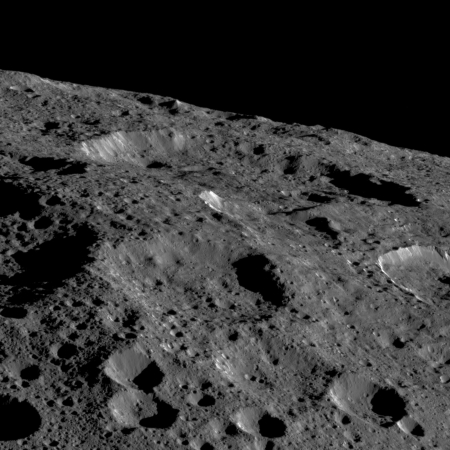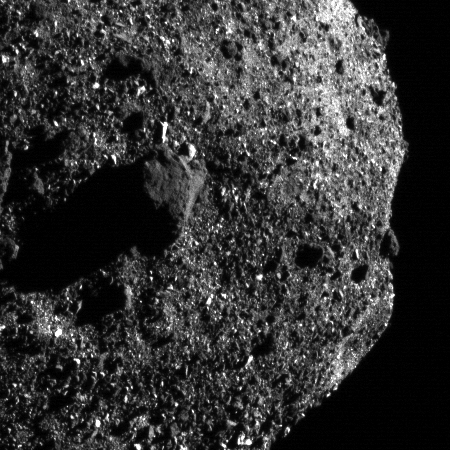New image of Ultima Thule
The New Horizons science team today released the newest and highest quality image yet of the Kuiper Belt object Ultima Thule. The image can be seen by clicking on the slightly reduced and cropped to the right.
Obtained with the wide-angle Multicolor Visible Imaging Camera (MVIC) component of New Horizons’ Ralph instrument, this image was taken when the KBO was 4,200 miles (6,700 kilometers) from the spacecraft, at 05:26 UT (12:26 a.m. EST) on Jan. 1 – just seven minutes before closest approach. With an original resolution of 440 feet (135 meters) per pixel, the image was stored in the spacecraft’s data memory and transmitted to Earth on Jan. 18-19. Scientists then sharpened the image to enhance fine detail. (This process – known as deconvolution – also amplifies the graininess of the image when viewed at high contrast.)
The oblique lighting of this image reveals new topographic details along the day/night boundary, or terminator, near the top. These details include numerous small pits up to about 0.4 miles (0.7 kilometers) in diameter. The large circular feature, about 4 miles (7 kilometers) across, on the smaller of the two lobes, also appears to be a deep depression. Not clear is whether these pits are impact craters or features resulting from other processes, such as “collapse pits” or the ancient venting of volatile materials.
They have only begun downloading the best data and images, so expect better images in the future.
The New Horizons science team today released the newest and highest quality image yet of the Kuiper Belt object Ultima Thule. The image can be seen by clicking on the slightly reduced and cropped to the right.
Obtained with the wide-angle Multicolor Visible Imaging Camera (MVIC) component of New Horizons’ Ralph instrument, this image was taken when the KBO was 4,200 miles (6,700 kilometers) from the spacecraft, at 05:26 UT (12:26 a.m. EST) on Jan. 1 – just seven minutes before closest approach. With an original resolution of 440 feet (135 meters) per pixel, the image was stored in the spacecraft’s data memory and transmitted to Earth on Jan. 18-19. Scientists then sharpened the image to enhance fine detail. (This process – known as deconvolution – also amplifies the graininess of the image when viewed at high contrast.)
The oblique lighting of this image reveals new topographic details along the day/night boundary, or terminator, near the top. These details include numerous small pits up to about 0.4 miles (0.7 kilometers) in diameter. The large circular feature, about 4 miles (7 kilometers) across, on the smaller of the two lobes, also appears to be a deep depression. Not clear is whether these pits are impact craters or features resulting from other processes, such as “collapse pits” or the ancient venting of volatile materials.
They have only begun downloading the best data and images, so expect better images in the future.






